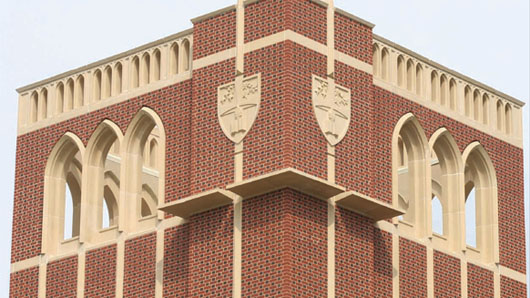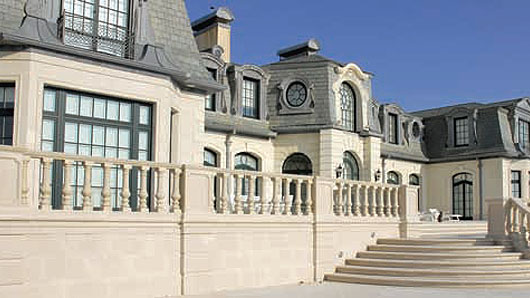March 3, 2010 7:15 AM CST

Cast Stone is alive and well in these challenging times. But — the construction industry struggles to maintain its’ equilibrium as the nation’s economy is challenged and many markets shrink. If the purchaser succumbs to the temptation of making the decision based solely upon price it is more than likely that they will face a dilemma with the resultant process. It’s a good time to think about basics.
Cast stone is a masonry product that provides ornamental or functional features to buildings and other structures. It gives the appearance of a variety of natural building stones, and applications range from the simplest windowsills to the most complicated architectural elements. Properly manufactured, it has the same or stronger physical properties as most dimensional building stone. In essence, cast stone is a highly refined architectural precast (concrete) product manufactured to simulate natural cut stone. Concrete is a basic building material that serves a multitude of construction applications. The ingredients are readily available, and the skills required to make concrete are relatively simple. So, what does “highly refined” mean? Basically, it means manufactured in compliance with a set of standards.
The recognized standard for cast stone is ASTM 1364 Standard Specification for Architectural Cast Stone, which requires a compressive strength greater than 6,500 psi as per ASTM C1194 test and maximum absorption rates of 6 percent and 10 percent for cold water and boiling methods, respectively as per ASTM C1195 test. The Cast Stone Institute requires producer members to comply with these specifications as well as ASTM C 666 – Standard Test Method for Resistance of Concrete to Rapid Freezing and Thawing. Also referenced within the ASTM C 1364 are myriad ASTM standards that regulate the ingredients of cast stone, such as cement, aggregates, reinforcing, color, etc.
Concrete and, therefore, cast stone can be fickle as evidenced by examples of failure in diverse applications. These failures are most predominately caused by human actions rather than ingredients. So, while it is a good start to assure compliance of ingredients with these standards, it is not enough. Additional standards regulate forming, mixing, placing, finishing, curing, storage, etc. It is prudent that producers follow these “basics” and document compliance in order to verify performance to the purchaser. That means keep records verifying test results and have certifications on-hand for all materials.

Today, cast stone is an alternative to natural, cut building stone. Cast stone can be integrally reinforced with steel and precisely colored through aggregates or mineral oxides. Mix designs have tested engineering values, which result in a predictable, durable life. Cast stone has strength and weathering qualities, since the manufacturing process is controlled. Repetitive treatment, either as trim or ornament, can be achieved quite economically in cast stone. The ability of cast stone to replicate deteriorating natural stone on existing buildings makes it an ideal material for the remodeling or restoration of old structures.
Typical cast stone elements include modular base panels, water table, sills, jambs, heads, keystones, door surrounds, cornice, pier caps, coping, band course, balustrade, stair treads & risers, plaques, quoins, signs, and columns.
Several manufacturing processes have been utilized in the storied history of cast stone, with mixed results. Modern cast stone is almost exclusively produced by the three processes defined by CSI Specification 04-72-00-04:
CSI’s contemporary initiatives address the challenges that most businesses struggle with during such an economic climate, providing accountability for the manufacturing process and offering added value to the end-user.
“Leadership for a national trade association requires the vision to look for opportunities that will: set your members above others in the industry, create and maintain market share, work with related associations toward common goals and much more,” says Jan Boyer, executive director. “The Cast Stone Institute believes in partnering within the cement-based products and masonry industries to work toward the common goals of appropriate sustainable development as a socially responsible initiative as well as building codes and standards that correctly specify our product toward building a safe, secure environment for communities.”
The word dilemma is defined as “a situation in which somebody must choose one of two or more unsatisfactory alternatives.”
There is an axiom that says “things equal to the same thing are equal to each other.”
In order for the product of a non-certified plant to be compared (equally) to that of a certified plant, it is reasonable to require verification of compliance with the usually requisite ASTM C 1364. To not do so is to risk ending up with an unsatisfactory alternative.
The Cast Stone Dilemma
By Gary Fry

Cast stone is a masonry product that provides ornamental or functional features to buildings and other structures. Photo courtesy of The Cast Stone Institute.
Cast Stone is alive and well in these challenging times. But — the construction industry struggles to maintain its’ equilibrium as the nation’s economy is challenged and many markets shrink. If the purchaser succumbs to the temptation of making the decision based solely upon price it is more than likely that they will face a dilemma with the resultant process. It’s a good time to think about basics.
Cast stone is a masonry product that provides ornamental or functional features to buildings and other structures. It gives the appearance of a variety of natural building stones, and applications range from the simplest windowsills to the most complicated architectural elements. Properly manufactured, it has the same or stronger physical properties as most dimensional building stone. In essence, cast stone is a highly refined architectural precast (concrete) product manufactured to simulate natural cut stone. Concrete is a basic building material that serves a multitude of construction applications. The ingredients are readily available, and the skills required to make concrete are relatively simple. So, what does “highly refined” mean? Basically, it means manufactured in compliance with a set of standards.
The recognized standard for cast stone is ASTM 1364 Standard Specification for Architectural Cast Stone, which requires a compressive strength greater than 6,500 psi as per ASTM C1194 test and maximum absorption rates of 6 percent and 10 percent for cold water and boiling methods, respectively as per ASTM C1195 test. The Cast Stone Institute requires producer members to comply with these specifications as well as ASTM C 666 – Standard Test Method for Resistance of Concrete to Rapid Freezing and Thawing. Also referenced within the ASTM C 1364 are myriad ASTM standards that regulate the ingredients of cast stone, such as cement, aggregates, reinforcing, color, etc.
Concrete and, therefore, cast stone can be fickle as evidenced by examples of failure in diverse applications. These failures are most predominately caused by human actions rather than ingredients. So, while it is a good start to assure compliance of ingredients with these standards, it is not enough. Additional standards regulate forming, mixing, placing, finishing, curing, storage, etc. It is prudent that producers follow these “basics” and document compliance in order to verify performance to the purchaser. That means keep records verifying test results and have certifications on-hand for all materials.

Cast stone is an alternative to natural, cut building stone. Photo courtesy of The Cast Stone Institute.
A Prime Building Material for Hundreds of Years
The earliest known use of cast stone dates to about the year 1138 and was seen at Carcassonne, France, the La Cité, which contains the finest remains of medieval fortification in Europe. Cast stone was first used extensively in London in the year 1900 and gained widespread acceptance in America in 1920.Today, cast stone is an alternative to natural, cut building stone. Cast stone can be integrally reinforced with steel and precisely colored through aggregates or mineral oxides. Mix designs have tested engineering values, which result in a predictable, durable life. Cast stone has strength and weathering qualities, since the manufacturing process is controlled. Repetitive treatment, either as trim or ornament, can be achieved quite economically in cast stone. The ability of cast stone to replicate deteriorating natural stone on existing buildings makes it an ideal material for the remodeling or restoration of old structures.
Typical cast stone elements include modular base panels, water table, sills, jambs, heads, keystones, door surrounds, cornice, pier caps, coping, band course, balustrade, stair treads & risers, plaques, quoins, signs, and columns.
Several manufacturing processes have been utilized in the storied history of cast stone, with mixed results. Modern cast stone is almost exclusively produced by the three processes defined by CSI Specification 04-72-00-04:
- Vibrant Dry Tamp (VDT) casting method: Vibratory ramming of earth moist, zero-slump concrete against a rigid mold until it is densely compacted.
- Machine casting method: Manufactured from earth moist, zero-slump concrete compacted by machinery using vibration and pressure against a mold until it becomes densely consolidated.
- Wet casting method: manufactured from measurable slump concrete and vibrated into a mold until it becomes densely consolidated.
CSI’s contemporary initiatives address the challenges that most businesses struggle with during such an economic climate, providing accountability for the manufacturing process and offering added value to the end-user.
“Leadership for a national trade association requires the vision to look for opportunities that will: set your members above others in the industry, create and maintain market share, work with related associations toward common goals and much more,” says Jan Boyer, executive director. “The Cast Stone Institute believes in partnering within the cement-based products and masonry industries to work toward the common goals of appropriate sustainable development as a socially responsible initiative as well as building codes and standards that correctly specify our product toward building a safe, secure environment for communities.”
The word dilemma is defined as “a situation in which somebody must choose one of two or more unsatisfactory alternatives.”
There is an axiom that says “things equal to the same thing are equal to each other.”
In order for the product of a non-certified plant to be compared (equally) to that of a certified plant, it is reasonable to require verification of compliance with the usually requisite ASTM C 1364. To not do so is to risk ending up with an unsatisfactory alternative.
How the Cream Will Rise
Quality cast stone producers and masons will do the right things during these challenging times, because they are competent and understand that short cuts cost more in the long run and are self-destructive. The purchasing decision must follow suit and provide quality product that has been manufactured in compliance with the appropriate standards. The purchaser best serves his requirements by including product in the list of choices that is demonstrably capable of fulfilling all of his requirements, not just those in the short run.About the Author
Gary Fry is immediate past-president of the Cast Stone Institute (CSI), having held the offices of secretary/treasurer and VP. Upon his recent retirement from Sun Precast Co., he was elected as an honorary member of CSI and continues to serve the Membership and Ethics committees. His 11-year tenure at Sun Precast as VP and president/CEO followed a diverse background in general construction and manufacturing.


















